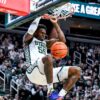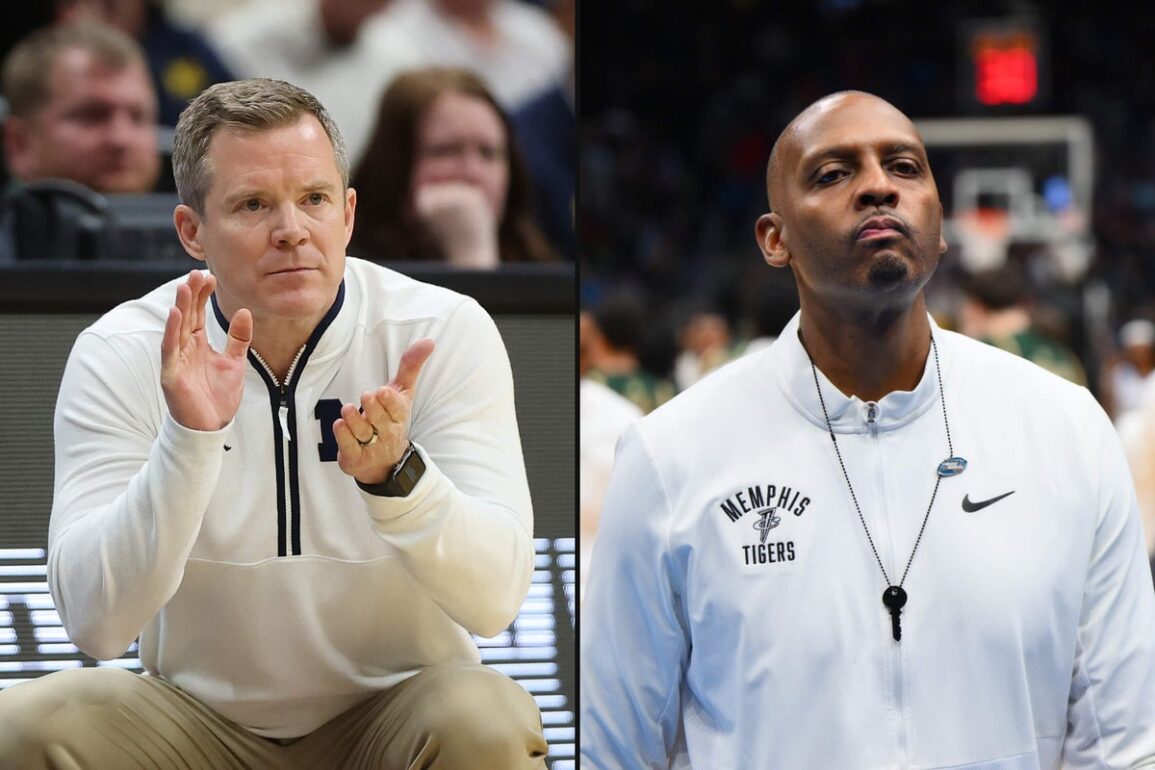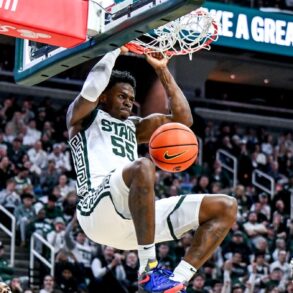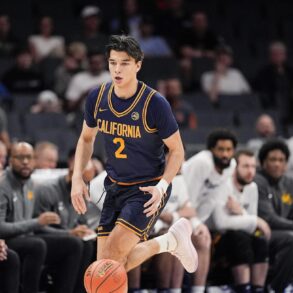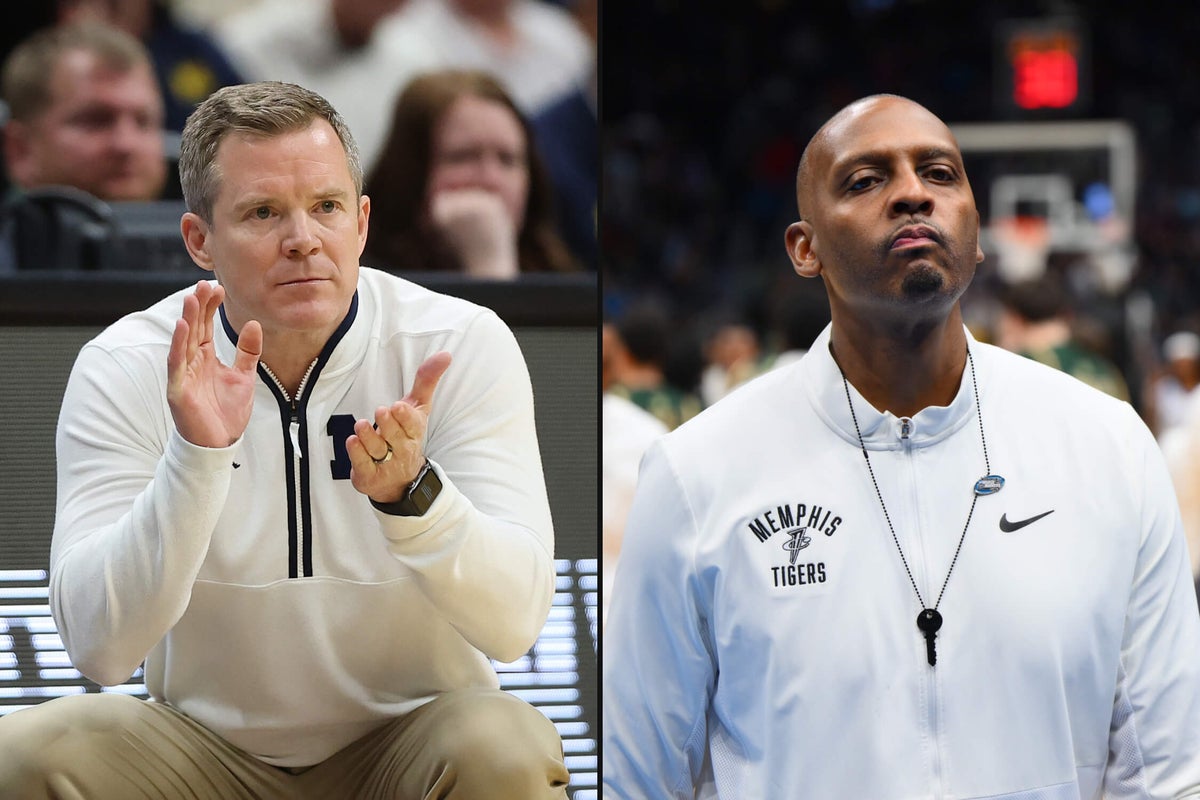
College basketball’s transfer portal closed to new entries on Tuesday, and while there are still a handful of uncommitted transfers among our Top 100, most rosters are set for next season.
In celebration of the portal closing, let’s anoint the winners and losers of this cycle.
Winners
Michigan
Portal additions: Yaxel Lendeborg, Morez Johnson Jr., Aday Mara, Elliot Cadeau
Advertisement
In his first season at Michigan, head coach Dusty May unleashed Yale transfer Danny Wolf as a playmaking forward, using him in different initiating actions, like a four-five pick-and-roll with fellow big Vlad Goldin. Wolf climbed draft boards as one of the best chess pieces in college hoops. Wolf and Goldin even got their own nickname (Area 51) and a song — and the effective and fun offense they powered could be the first chapter of May’s success story in turning Michigan back into a perennial winner. It certainly helped the Wolverines in the portal.
May once again landed what looks like the best portal frontcourt in the country. Lendeborg will ideally be employed as the new playmaking forward in Michigan’s offense. He has a head start on where Wolf was when he arrived on campus: Wolf had just a 15.4 assist rate in 2023-24 at Yale (which jumped to 22.7 at Michigan); Lendeborg had a 22.9 assist rate at UAB this season. Lendeborg is testing the NBA Draft waters, and if he stays in, Michigan is still set up well up front with Johnson and Mara, two players with high upsides.
Michigan struggled with turnovers last year, and May hoped to address that by landing more of a traditional setup man in Cadeau. Cadeau did have a high turnover rate at UNC but is a gifted passer and ranked 13th nationally in assist rate. With the return of Nimari Burnett, Roddy Gayle and LJ Cason on the perimeter along with incoming four-star freshmen Trey McKenney (a top-25 recruit) and Winters Grady, this is a well-rounded roster that should once again compete near the top of the Big Ten. And if he makes it to Ann Arbor, Lendeborg, who is also an elite rebounder and a better scorer than Wolf, could be a National Player of the Year candidate.
Louisville
Portal additions: Ryan Conwell, Isaac McKneely, Adrian Wooley
The Cards worked quickly this cycle to secure one of the top backcourts for Year 2 of Pat Kelsey’s fun-and-gun system. Conwell is a proven scorer who already had a lot of success in a similar offense while playing for Josh Schertz at Indiana State. McKneely was one of the best shooters available in the portal, and he should take over the role vacated by Reyne Smith. Then Kelsey has two high-upside pieces to replace Chucky Hepburn at point guard in Wooley and five-star freshman Mikel Brown Jr. Both are NBA prospects.
Advertisement
Louisville had the luxury of focusing its efforts on the backcourt because the frontcourt should be stronger and deeper with the return of Aly Khalifa, who transferred in from BYU last year but redshirted because of a knee injury, and Kasean Pryor, who looked to be one of the Louisville’s best players until he tore his ACL at the Battle 4 Atlantis. The Cards also return James Scott and added Sananda Fru, a 6-11, 21-year-old German power forward who started on a team in Germany’s top professional league. This is a deeper and more talented roster than the one that just went 18-2 in the ACC.
Kentucky
Portal additions: Jayden Quaintance, Jaland Lowe, Denzel Aberdeen, Kam Williams, Mouhamed Dioubate
It only makes sense to list these teams back-to-back. The rivalry is back, and Kentucky has a deeeep roster. Head coach Mark Pope has so many options he might have to adopt the hockey line change strategy John Calipari used in 2015. The Wildcats will have healthy competition at just about every position. The only lock is that Otega Oweh, if he returns, should be a starter. Outside of that, it looks like Pope is trying to give himself options everywhere.
The Cats appeared locked into Lowe at point guard, but that’s murkier after the addition of Aberdeen, a surprise late portal entrant who would have finally been a starter at Florida after spending this season as a super sub for the national champs. It’s possible both start together. Incoming freshman Jasper Johnson and Collin Chandler are also candidates to start on the perimeter, especially if Oweh stays in the draft. The power forward spot will likely be manned by Dioubate or Croatian Andrija Jelavic. Going smaller is also an option with Williams, the Tulane transfer, who could also play in bigger lineups at the three. Brandon Garrison will likely be the starting center early on while Quaintance recovers from ACL surgery, but the Arizona State transfer is a projected lottery pick and was an All-Big 12 defensive selection. Malachi Moreno, a consensus top-30 player in the 2025 class, is yet another option at center. And off the bench, Pope also has Travis Perry and Trent Noah, who both had their moments as freshmen and will have a leg up on the newcomers in familiarity with Pope’s system.
That’s a lot to manage, but Pope lived that life during the Rick Pitino days, where competition caused by depth seemed to be healthy for the program. Offensively, I’m betting on Pope figuring it out. The less proven side of the ball in his coaching career is the defense, and that’s what seemed to be the priority during this portal cycle. I love the Dioubate addition because he has the kind of facilitating abilities on the offensive end that fit Pope’s system, and his effort and defensive versatility are huge positives. He’s the type of player everyone seems to feed off. Lineups that include the foursome of Aberdeen, Oweh, Dioubate and Quaintance would be extremely hard to score against. The 2024-25 team, while awesome offensively, was not a legitimate title contender because of its defense. This roster seems to have everything on paper. Now we’ll see how it meshes.
Advertisement
Iowa
Portal additions: Bennett Stirtz, Alvaro Folgueiras, Brendan Hausen, Tavion Banks, Isaia Howard, Cam Manyawu, Kael Combs
Ben McCollum’s best teams at Northwest Missouri State had a star point guard and a stretch big. Last year at Drake, McCollum had the star point guard in Bennett Stirtz but was missing the stretch big. McCollum got Stirtz, the top transfer in our rankings, to follow him to Iowa, and now he has his stretch big in Folgueiras, who was the Horizon League player of the year at Robert Morris and went for 15 points, 10 boards and four assists in an NCAA Tournament loss to Alabama. Folgueiras should be perfect in McCollum’s system and help open the floor for Stirtz. McCollum also got his Mitch Mascari replacement in Kansas State transfer Hausen, who made 90 3s this past season.
McCollum had four other Drake rotation guys follow him along with Stirtz, most notably Manyawu and Banks. Both are slightly undersized for the high-major level but have the athleticism to make up for it. McCollum was convinced last preseason that Howard would eventually end up at the high-major level, so pencil him into the 2025-26 the breakout list. As McCollum proved in his first year at Drake, continuity matters when it comes to his system. Iowa is still looking for one more guard to round out its rotation, but with the talent of Stirtz, the history of McCollum and the addition of a player like Folgueiras, I’m tempted to put the Hawkeyes in my next Top 25.
Arkansas
Portal additions: Malique Ewin, Nick Pringle
Ewin was one of my favorite bigs available in the portal, and you would think he’d benefit from playing alongside more talented teammates. The question is how John Calipari will use him. Cal should try to copy the plan from two years ago at Kentucky, when he used Tre Mitchell in more of a facilitating role early in the season. It’s possible Ewin didn’t pick the best system for his abilities, but Arkansas’ frontcourt is in great shape with Ewin, the return of Trevon Brazile and the addition of Pringle for defensive reinforcements. Cal also has an extra intriguing piece up front with the addition of Lebanese forward Karim Rtail.
Arkansas was already deep in the backcourt with the return of DJ Wagner, Karter Knox (who declared for draft but will likely return) and Billy Richmond, along with the addition of five-stars Darius Acuff Jr. and Meleek Thomas. It looks pretty good on paper, as Calipari teams tend to. Shooting and a glut of ball-dominant guards are worthy concerns, but Ewin could be the connective piece that makes it work.
Auburn
Portal additions: Kevin Overton, KeShawn Murphy, Keyshawn Hall, Elyjah Freeman
Advertisement
One of the biggest surprises of the portal window was Chad Baker-Mazara leaving Auburn. With Bruce Pearl graduating most of his rotation, it would have been nice to potentially return Tahaad Pettiford and Baker-Mazara for at least some continuity from a Final Four team, but now it’s just Pettiford, assuming he doesn’t stay in the NBA Draft.
So you could make the argument for Auburn as a portal loser, but I like the roster Pearl built on the fly, especially if Pettiford is back. Murphy, who averaged 11.7 points and 7.4 rebounds at Mississippi State, helps offset some of what will be lost defensively by the graduation of Dylan Cardwell, and Murphy provides some more offensive pop at that spot. Hall was one of the best scorers in the Big 12. He’s different than Johni Broome, but he’s a good candidate to become the isolation mismatch in Pearl’s offense that Broome was.
Freeman, a Division II transfer from Lincoln Memorial, is a bit of a wild card. The same could be written of top-ranked junior college transfer Abdul Bashir. Freeman’s film really pops: He’s 6-7 with NBA twitch and shot close to 40 percent from 3. Auburn has a good track record with those types. Remember, Chaney Johnson was a Division II transfer. I am also a fan of the Overton addition. He’s a secondary handler who isn’t as proven a shooter as Baker-Mazara but is more dynamic off the bounce. The Tigers may have to lean more on freshmen to provide depth, and it may have been nice to have one or two more proven high-major additions, but I’m intrigued. This is a team I’ll put on my must-watch list in November.
Losers
Memphis
The big news here is PJ Haggerty, a second-team All-American who entered the portal reportedly looking for a bigger payday and a chance to play point guard. Tigers coach Penny Hardaway met with reporters on Tuesday and said “some of these numbers are crazy” in regard to what players are getting paid and that Haggerty “didn’t close the door on us.” So it’s possible Haggerty isn’t able to find anyone willing to match his asking price and Hardaway will welcome him back, but I wouldn’t bet on it.
The more concerning storyline here is that Memphis has typically has operated with high-major talent in a mid-major-plus league. In last year’s cycle, Hardaway built a high-major roster with well-known commodities like Haggerty, Tyrese Hunter, Dain Dainja, Colby Rogers and Moussa Cisse. The first three were in our portal rankings a year ago. Everyone except for Haggerty is out of eligibility, and in this cycle, not one of Hardaway’s five portal additions is in our top 100. (Dainja is trying to get an extra year of eligibility, but I’m not convinced he has a surefire case.)
According to 247Sports’ database, Memphis still has the top portal class in the American, but it ranks 54th nationally, compared to last year’s class that ranked 11th. Rules and budgets are constantly changing in this new era, but could this be a sign that Memphis’ inability to find itself in a high-major league after all of these years of conference realignment is catching up to the basketball program? The Tigers looked to rebound from a down year this past season but still wasn’t able to get out of the first round of the NCAA Tournament.
The Tigers will likely still be the favorite in the AAC in 2025-26 and most years going forward, but if tourney success doesn’t eventually follow, is that considered a success? I don’t blame Hardaway or Memphis for being unwilling to pay Haggerty’s price — I’m skeptical of his fit as a point guard and his ability to carry a second- or third-weekend team in the NCAA Tournament — but this situation is playing out in a way that could spell trouble for Memphis’ standing in college hoops.
Advertisement
UAB
Every player in the Blazers’ rotation with eligibility remaining has hit the portal, led by Yaxel Lendeborg. Andy Kennedy is always good at finding players and rebuilding a roster, but this is a massive undertaking. So far UAB has just one portal commitment: former Auburn/Syracuse wing Chance Westry, who has played 115 minutes in two seasons. A few years ago the AAC looked like it could be a level above the other leagues in its tier, such as the Atlantic-10. But with the A-10 in position to benefit from the House settlement’s direct revenue sharing system because of the absence of FBS football at those universities, the league’s top men’s basketball programs seem to be in much better shape than those in the AAC.
Baylor
Baylor was the victim of the most newsworthy poaching of this cycle, with point guard Rob Wright III jumping in the portal for a higher bidder and landing at BYU. Wright was a big part of Baylor’s 2025-26 plans, and he entered late enough in the cycle (April 7) to eliminate most contingency plans. Baylor did land a point guard in JJ White, an All-Summit League first-teamer, but the Bears went from having one of the top returning point guards in the country to relying on one who will be making a sizable jump in competition level. Baylor’s portal class doesn’t have the star appeal of last year’s group, but that’s not necessarily a bad thing. Spending big on three players last year got the Bears a seventh-place finish in the Big 12 and one NCAA Tournament win. Maybe the pieces will fit better together and Scott Drew will be able to spend more resources addressing his depth, which was an issue this past season. We’ll see how it comes together, but Wright was a box Baylor thought it had checked; now he’s a reminder no commitment is safe in college basketball’s modern era.
Georgia Tech
Georgia Tech lost five players to the portal who started games for a team that went .500 in the ACC this past year, including two (Naithan George and Ibrahim Souare) to leaguemate Syracuse. Georgia Tech does have the No. 22 recruiting class coming in per 247Sports Composite ratings and landed Miami (Ohio) transfer Kam Craft, a 43.1 percent 3-point shooter who scored 40 points in a game this season. So maybe the Yellow Jackets will be fine, but it’s a real killer to find a recruiting steal like George, he starts 62 games for you in two years and then he transfers. The portal has obviously been hard on mid-majors, but it has also made it difficult for middle- or bottom-tier high-major teams to retain talent.
UCF/Arizona State
Johnny Dawkins and Bobby Hurley enter 2025-26 on the hot seat, and both have to rebuild their teams after everyone of note hit the portal. UCF might have even received some preseason Top 25 votes if Keyshawn Hall and Moustapha Thiam returned, but Hall is headed to Auburn and Thiam to Cincinnati. Hurley got what looked like huge recruiting wins last year when he landed Jayden Quaintance and Joson Sanon. Both played a lot of minutes as freshmen, the Sun Devils won 13 games and now they’re off to Kentucky and St. John’s, respectively. Things really look bleak when you look at what both have coming back.
UCF’s lone returner: Poohpha Warakulnukroh, who played a total of four minutes and did not attempt a shot in 2024-25. Arizona State returns just one player who scored a point last season: Trevor Best, who averaged 3.6 points over 11 games.
Not ideal circumstances for either program in one of the deepest leagues in the country.
(Top photos of Dusty May and Penny Hardaway: Matthew Stockman / Getty Images; Steven Bisig / Imagn Images)
This post was originally published on this site be sure to check out more of their content.


